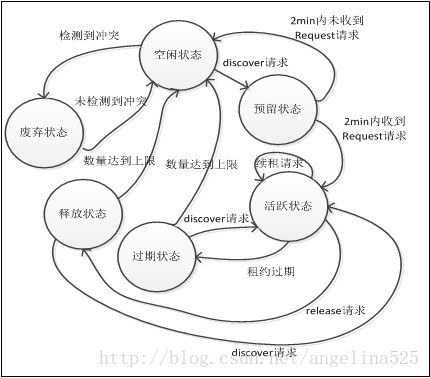ISC DHCP租约分析
租约状态转换
DHCP服务系统中的租约共有八种状态:空闲状态、预留状态、活跃状态、过期状态、释放状态、废弃状态、重置状态、备份状态。重置状态和备份状态为启动FAILOVER模块后,主从服务器通过通信设置,在此不做讨论,其它六种状态的转换如图3-6所示:

图3-6 租约状态转移图
如图3-6所示,租约状态转换条件如下:
空闲状态变成预留状态:当服务器收到DHCPDISCOVER请求时,从空闲租约表中选择一个可用的空闲租约分配给客户端,设置该租约超时时间为2分钟,将该租约设置成预留状态,并放入预留租约表中,表示该租约暂时不能分配给其他客户端。
预留状态变成空闲状态:2分钟内未收到客户端的DHCPREQUEST请求,说明未收到客户端的租约确认消息,将该租约重新设置成空闲状态,并插入空闲租约表中。
预留状态变成活跃状态:2分钟内收到客户端的DHCPREQUEST请求,说明该客户端接收了服务器为其分配的租约,将该租约设置成活跃状态,并插入活跃租约表中,表示该租约正在被某个客户端使用。
活跃状态保持活跃状态:当收到客户端的续租请求,从活跃租约表中取出租约,更新租约过期时间,并按新的过期时间将租约插入活跃租期表相应位置,该租约仍然保持活跃状态。
活跃状态变成过期状态:活跃状态的租约会连成一个活跃租期表,且按租约到期的先后顺序排序,服务器每隔20s会检查活跃租期表中的第一个租期是否到期,若到期将该租约设置成过期状态,且放入过期租约表中。
过期状态变成活跃状态:当收到客户端DHCPREQUEST请求时,所请求的租约在过期租约表中,则将该租约从过期租约表中取出,更新租约状态为活跃状态,并将租约插入活跃租期表中。
活跃状态变成释放状态:当收到客户端的DHCPRELEASE请求时,将相应的活跃租期从活跃租期表取出,更新该租约为释放状态,并插入释放租约表中。
释放状态变成活跃状态:当收到客户端DHCPREQUEST请求时,所请求的租约在释放租约表中,则将该租约从释放租约表中取出,更新租约状态为活跃状态,并将租约插入活跃租期表中。
释放状态/过期状态变成空闲状态:当释放租约表/空闲租约表中的租约超过阈值时,将该租约表中一半的租约从该表中取出,将它们更新为空闲状态,并插入空闲租约表中。
空闲状态变成废弃状态:当将一个空闲租约分配给客户端前,服务器发送ping包检测该IP是否已被使用,若收到ping应答包,说明该租约已被使用,于是将该租约设置成废弃状态,并插入废弃租约表中。
废弃状态变成空闲状态:当空闲租约表的租约不够用时,服务器向废弃租约表中的每个IP发送ping包,若未收到某个IP地址的应答包,则说明该IP已未被使用,将该IP所对应的租约设置成空闲状态,并插入空闲租约表中。
维护地址池的租期代码分析
根据dhcp协议规定,默认情况下client需要在T1/T2这两个时间向server发送DHCPREQUEST来续租ip(T1 = 50% * 租期, T2 = 87.5% * 租期)。当然,client在T1时刻发送DHCPREQUEST后没有收到对应的DHCPACK,才会在T2时刻再次尝试发送DHCPREQUEST。对server来说,如果在整个租期内都没有收到client的DHCPREQUEST续租请求,则需要重置lease的状态,使其可以被分配给其他client。
以下就根据isc-dhcp的代码,主要从两个方面来简单分析server端是如何维护地址池租期的。
(注:在lease结构体中关键的成员starts/ends/sort_time,分别表示lease的开始/结束/下次排序时间)
1. 续租成功,更新lease
在server收到client发来的DHCPREQUEST报文后,构建DHCPACK回复时,同时更新对应lease的开始和结束时间。可以看看isc-dhcp中的代码:
-
/* At this point, we have a lease that we can offer the client.
-
Now we construct a lease structure that contains what we want,
-
and call supersede_lease to do the right thing with it. */
-
lt = (struct lease *)0;
-
result = lease_allocate (<, MDL);
-
if (result != ISC_R_SUCCESS) {
-
log_info ("%s: can't allocate temporary lease structure: %s",
-
msg, isc_result_totext (result));
-
free_lease_state (state, MDL);
-
if (host)
-
host_dereference (&host, MDL);
-
return;
-
}
-
-
/* Use the ip address of the lease that we finally found in
-
the database. */
-
lt -> ip_addr = lease -> ip_addr;
-
/* Start now. */
-
lt -> starts = cur_time;
-
/* Figure out how long a lease to assign. If this is a
-
dynamic BOOTP lease, its duration must be infinite. */
-
if (offer) {
-
……
-
} else {
-
lt->flags |= BOOTP_LEASE;
-
……
-
lt -> ends = state -> offered_expiry = cur_time + lease_time;
-
lt -> next_binding_state = FTS_ACTIVE;
-
}
2. 租约到期,释放lease
定时器是个很好的工具,但此处不对isc的timer做介绍。主要阅读dhcp的定时更新地址池内leases的代码。
-
/* Timer called when a lease in a particular pool expires. */
-
void pool_timer (vpool)
-
void *vpool;
-
{
-
struct pool *pool;
-
struct lease *next = (struct lease *)0;
-
struct lease *lease = (struct lease *)0;
-
-
-
-
-
-
-
struct lease **lptr[RESERVED_LEASES+1];
-
TIME next_expiry = MAX_TIME;
-
int i;
-
struct timeval tv; // 定时器时间间隔
-
pool = (struct pool *)vpool;
-
lptr [FREE_LEASES] = &pool -> free;
-
lptr [ACTIVE_LEASES] = &pool -> active;
-
lptr [EXPIRED_LEASES] = &pool -> expired;
-
lptr [ABANDONED_LEASES] = &pool -> abandoned;
-
lptr [BACKUP_LEASES] = &pool -> backup;
-
lptr[RESERVED_LEASES] = &pool->reserved;
-
/* 遍历所有状态下的lease */
-
for (i = FREE_LEASES; i <= RESERVED_LEASES; i++) {
-
/* If there's nothing on the queue, skip it. */
-
if (!*(lptr [i]))
-
continue;
-
-
……
-
-
lease_reference (&lease, *(lptr [i]), MDL);
-
while (lease) {
-
/* Remember the next lease in the list. */
-
if (next)
-
lease_dereference (&next, MDL);
-
if (lease -> next)
-
lease_reference (&next, lease -> next, MDL);
-
/* If we've run out of things to expire on this list, stop. */
-
/* 由于一开始就维护着链表按时间来排序,当sort_time
-
在cur_time之后,则可以终止本次遍历。因为接下来的
-
所有lease的sort_time均大于cur_time */
-
if (lease -> sort_time > cur_time) {
-
if (lease -> sort_time < next_expiry)
-
next_expiry = lease -> sort_time;
-
break;
-
}
-
/* If there is a pending state change, and
-
this lease has gotten to the time when the
-
state change should happen, just call
-
supersede_lease on it to make the change
-
happen. */
-
if (lease->next_binding_state != lease->binding_state)
-
{
-
-
……
-
-
/* 更改lease状态 */
-
supersede_lease(lease, NULL, 1, 1, 1);
-
}
-
lease_dereference (&lease, MDL);
-
if (next)
-
lease_reference (&lease, next, MDL);
-
}
-
if (next)
-
lease_dereference (&next, MDL);
-
if (lease)
-
lease_dereference (&lease, MDL);
-
}
-
if (next_expiry != MAX_TIME) {
-
pool -> next_event_time = next_expiry;
-
tv . tv_sec = pool -> next_event_time;
-
tv . tv_usec = 0;
-
/* 设置下次pool_timer执行时间 */
-
add_timeout (&tv, pool_timer, pool,
-
(tvref_t)pool_reference,
-
(tvunref_t)pool_dereference);
-
} else
-
pool -> next_event_time = MIN_TIME;
-
}




【推荐】国内首个AI IDE,深度理解中文开发场景,立即下载体验Trae
【推荐】编程新体验,更懂你的AI,立即体验豆包MarsCode编程助手
【推荐】抖音旗下AI助手豆包,你的智能百科全书,全免费不限次数
【推荐】轻量又高性能的 SSH 工具 IShell:AI 加持,快人一步
· TypeScript + Deepseek 打造卜卦网站:技术与玄学的结合
· Manus的开源复刻OpenManus初探
· AI 智能体引爆开源社区「GitHub 热点速览」
· 三行代码完成国际化适配,妙~啊~
· .NET Core 中如何实现缓存的预热?